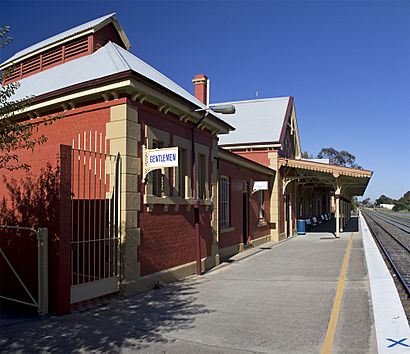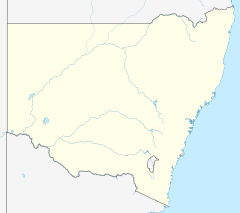Queanbeyan railway station facts for kids
Quick facts for kids
Queanbeyan
|
|||||||||||
|---|---|---|---|---|---|---|---|---|---|---|---|

Southbound view in January 2012
|
|||||||||||
| Location | Henderson Street, Queanbeyan | ||||||||||
| Coordinates | 35°20′34″S 149°13′37″E / 35.3428°S 149.2270°E | ||||||||||
| Owned by | Transport Asset Holding Entity | ||||||||||
| Operated by | NSW TrainLink | ||||||||||
| Line(s) | Bombala | ||||||||||
| Distance | 321.46 kilometres from Central | ||||||||||
| Platforms | 1 | ||||||||||
| Tracks | 3 | ||||||||||
| Connections | Bus | ||||||||||
| Construction | |||||||||||
| Structure type | Ground | ||||||||||
| Disabled access | Yes | ||||||||||
| Other information | |||||||||||
| Station code | QBN | ||||||||||
| History | |||||||||||
| Opened | 8 September 1887 | ||||||||||
| Services | |||||||||||
|
|||||||||||
| Location | |||||||||||
Queanbeyan railway station is a special old train station in New South Wales, Australia. It's on the Bombala line and serves the town of Queanbeyan. This station is listed as a heritage site, which means it's an important historical place.
Contents
History of Queanbeyan Station
Queanbeyan station first opened on 8 September 1887. This happened when the train line was extended from Bungendore. The station was added to the New South Wales State Heritage Register on 2 April 1999. This register lists places that are important to the history of New South Wales.
Building the Station
The area chosen for the station was called Oaks Paddock. It was about two kilometers from the town center. This spot was picked so that no buildings like the hospital or cemetery had to be moved. The station was finished in March 1887 and started operating in September of that year.
The main station building, the station master's house, and a gatekeeper's cottage were all built at the same time. They were likely finished in 1887.
Why Queanbeyan Station is Special
In 1884, the government decided that new train stations should be built using cheaper materials like timber and iron. But Queanbeyan station was different. It was one of only 10 stations built between 1887 and 1892 that used bricks. Most other stations built then used less expensive materials. This shows how important Queanbeyan station was considered in the train network.
The train platform was built on the south side of the railway line. There was also a special track for carriages and a loop for moving trains. A loading area and a goods shed were also on the south side.
Connecting to Other Towns
Queanbeyan was the end of the line until 8 December 1887. On that date, the line was extended further to Michelago.
In March 1913, Queanbeyan became a junction station. This means it became a place where train lines split off in different directions. This happened when construction began on the line that goes to Canberra.
Over the years, many changes were made to the station area. These included adding offices, a loading bank, and an engine shed. A large crane was installed in 1903. A special siding was added in 1913 to unload materials for the Canberra train line. A turntable, which helps turn trains around, was moved to Queanbeyan in 1926. The refreshment rooms, where people could eat, closed in 1956.
Until September 1988, a train called the Canberra Monaro Express would split at Queanbeyan. One part would go to Canberra and the other to Cooma. Around 1999, part of the goods yard was given to the local council for community use.
Train Services at Queanbeyan
Queanbeyan station has three NSW TrainLink Xplorer train services every day. These trains travel in both directions, connecting Sydney and Canberra.
NSW TrainLink also runs a bus service from Queanbeyan. This bus goes to Cootamundra.
The station is also often used by special trains from the Canberra Railway Museum.
| Platform | Line | Stopping pattern | Notes |
| 1 |
Southern Region
|
services to Sydney Central & Canberra |
|---|
What Queanbeyan Station Looks Like
The heritage-listed station complex includes several important parts. These are the main brick station building from 1887, the brick platform, and a signal box from the 1920s. There's also the station master's house, a signal frame, a turntable, a water column, a water tank, and a small shed.
The Station Building (1887)
Queanbeyan's station building is the largest and most detailed on the Bombala Line. It looks balanced and grand. The building has a central waiting room. On one side, there's a kitchen, storeroom, refreshment room, and dining room. On the other side, there's the Station Master's office, a parcels room, a ladies' waiting room, and bathrooms.
The building is made of brick and painted. The roofs are sloped and covered with corrugated iron. They have brick chimneys and vents. The main building has decorative timber boards and arched windows. The platform and back veranda have wooden posts with curved iron brackets. The doors are timber French doors and the windows are timber double-hung sash windows.
The Platform
The platform at Queanbeyan Station is quite unique. It's one of only eleven stations in New South Wales that still has a precast concrete platform structure. These types of platforms are becoming very rare. Experts are looking into ways to show how special this platform is, perhaps with information signs.
Signal Box (1920s) and Signal Frame
The two signalling buildings are simple square structures. They have single sloped roofs covered in corrugated iron. Their walls are made of timber frames covered with weatherboard or hardiplank.
Station Master's Residence (1887)
The brick house where the Station Master lived has a standard L-shape. It has a balanced front with a wide verandah. The roof is sloped and covered in corrugated iron, and it has brick chimneys.
Most of the station's original parts are still in great condition. This includes the station building, the Station Master's house, the platform, the signal box, the signal frame, the turntable, the water column, and the water tank.
Why Queanbeyan Station is a Heritage Site
Queanbeyan Railway Precinct is very important to the history of New South Wales. It's a late Victorian-era railway area that is still mostly as it was when it was built. It includes original items from the 1880s, like the station building and the Station Master's house.
The station building is especially important. It's a great example of a first-class Victorian station building. It's the biggest and most decorated station on the Bombala Line. This shows that Queanbeyan was an important place in Southern NSW, even before Canberra became Australia's capital city.
Queanbeyan railway station was added to the New South Wales State Heritage Register on 2 April 1999 because it meets several important requirements:
Historical Importance
This place is important because it shows how the NSW railways grew in the late 1800s. It has many items from when the line opened in Queanbeyan in 1887. It also shows how a railway station was set up in the late 19th century. The station building, being the largest and most ornate, highlights Queanbeyan's significance before Canberra became the national capital.
Design and Beauty
The station has a special beauty because it still has many original items that show railway design from the 1880s. The 1887 station building is a beautiful example of a first-class Victorian station. It has details typical of that time. The 1887 Station Master's residence is also a good example of a standard Victorian railway house.
Community Connection
The station is important to the local community. For many years, it provided jobs, helped with trade, and was a place for people to connect. It helps the community feel connected to their past and is a special part of daily life for many people.
Typical Railway Features
The station building is a good example of a first-class station building, similar to others from that time in NSW. Other parts, like the Station Master's house, signal box, signal frame, shed, turntable, water column, and water tank, show common railway practices and designs from the late 1800s and early 1900s across New South Wales.


